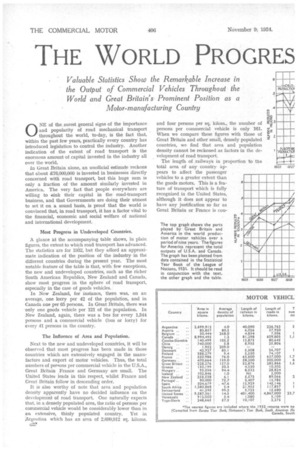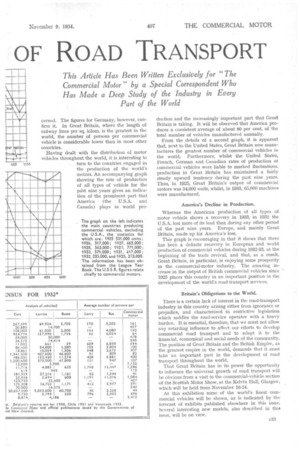THE WORLD PROGRES OF ROAD TRANSPORT
Page 62

Page 63

If you've noticed an error in this article please click here to report it so we can fix it.
0 NE of the surest general signs of the importance and popularity of road mechanical transport throughout the world, to-day, is the fact that, within the past few years, practically every country has introduced legislation to control the industry. Another indication of the extent of road transport is the enormous amount of capital invested in the industry all over the world.
In Great Britain alone, an unofficial estimate reckons that about £76,000,000 is invested in businesses directly concerned with road transport, but this huge sum is only a fraction of the amount similarly invested in America. The very fact that people everywhere are willing to 'sink their capital in the road-transport business, and that Governments are doing their utmost to set it on a sound basis, is proof that the world is convinced that, in road transport, it has a factor vital to the financial, economic and social welfare of national and international development.
Most Progress in Undeveloped Countries.
A glance at the accompanying table shows, in plain figures, the extent to which road transport has advanced. The statistics are for 1932, but they afford an approximate indication of the position of the industry in the different countries during the present year. The most notable feature of the table is that, with few exceptions, the new and undeveloped countries, such as the richer South American Republics, New Zealand and Canada, show most progress in the sphere of road transport, especially in the case of goods vehicles.
In New Zealand, for instance, there was, on an average, one lorry per 42 of the population, and in Canada one per 65 persons. In Great Britain, there was only one goods vehicle per 121 of the population. In New Zealand, again, there was a bus for every 1,344 persons and a commercial vehicle (bus or lorry) for every 41 persons in the country.
The Influence of Area and Population.
Next to the new and undeveloped countries, it will be observed that most progress has been made in those countries which are extensively engaged in the manufacture and export of motor vehicles. Thus, the total numbers of perHons per commercial vehicle in the U.S.A., Great Britain ,France and Germany are small. The United States leads in this respect, whilst France and Great Britain follow in descending order.
It is also worthy of note that area and population density apparently have no decided influence on the development of road transport. One naturally expects that, in a densely populated area, the ratio of persons per commercial vehicle would be considerably lower than in an extensive, thinly populated country. Yet in Argentina which has an area of 2,699,912 sq. kiloms. and four persons per sq. kilom., the number of persons per commercial vehicle is only 161. When we compare these figures with those of Great Britain and other small, densely populated countries, we find that area and population density cannot be reckoned as factors in the development of road transport.
The length of railways in proportion to tho total area of any country appears to affect the passenger vehicles to a greater extent than the goods motors. This is a feature of transport which is fully recognized in the United States, although it does not appear to have any justification so far as Great Britain or France is con cerned. The figures for Germany, however, confirm it. In Great Britain, where the length of railway lines per sq. Idiom, is the greatest in the world, the number of persons per coMmercial vehicle is considerable lower than in most other countries.
Having dealt with the distribution of motor vehicles throughout the world, it is interesting to turn to the countries engaged in the production of the world's motors. An accompanying graph showing the rate of production of all types of vehicle for the pa:-st nine years gives an indication of the prominent part that America (the U.S.A. and Canada) plays in world pro.
duction and the increasingly important part that Great Britain is taking. It will be observed that America produces a consistent average of about 80 per cent, of the total number of vehicles manufactured annually.
From the details of a second graph, it is apparent tha't, next to the United States, Great Britain now manufactures the greatest number of commercial vehicles in the world. Furthermore, whilst the United States, French, German and Canadian rates of production of commercial vehicles were liable to marked fluctuations. production in Great Britain has maintained a fairly steady upward tendency during the past nine years. Thus, in 1925, Great Britain's output of commercial motors was 34,000 units, whilst, in 1933, 65,000 machines were manufactured.
America's Decline in Production.
Whereas the American production of all types of motor vehicle shows .3 recovery in 1933, in 1932 the U.S.A. lost more of its lead than during any other period of the past nine years. Europe, and mainly Great Britain, made up for America's loss.
This graph is encouraging in that it shows that there has been a definite recovery in European and world production of commercial vehicles during 1932-33, at the beginning of the trade revival, and that, as a result, Great Britain, in particular, is enjoying some prosperity in the commercial-motor industry. The amazing increase in the output of British commercial vehicles since 1925 places this country in an important position in the development of the world's road-transport services.
Britain's Obligations to the World.
There is a certain lack of interest in the road-transport industry in this country arising either from ignorance or prejudice, and characterized in restrictive legislation which saddles the road-service operator with a heavy burden. It. is essential, therefore, that we must not allow any retarding influence to affect our efforts to develop commercial road transport and to adapt it to the financial, economical and social needs of the community. The position of Great Britain and the British Empire, as the greatest empire in the world, demands that it must take an important part in the development of road transport throughout the world.
That Great Britain has in its power the opportunity to influence the universal growth of road transport will be obvious from a visit to the commercial-vehicle section of the Scottish Motor Show, at the Kelvin Hall, Glasgow, which will be held from November 16-24.
At this exhibition some of the world's finest commercial vehicles will be shown, as is indicated by the forecast of exhibits published elsewhere in this issue. Several interesting new models, also described in this issue, will be on view.
























































































































